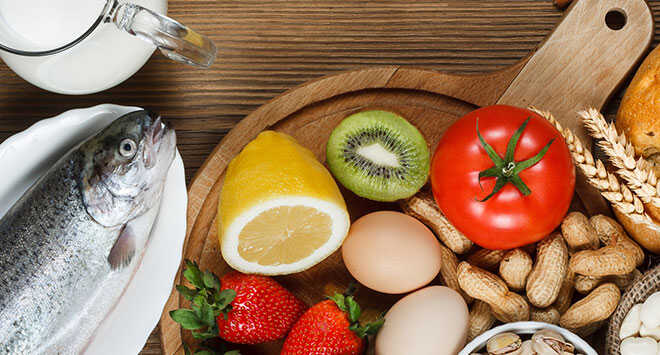
What is Allergen-Free Food? What You Need to Know

If you have a food allergy, eating allergen-free foods is crucial. But what exactly does that mean? This guide covers common food allergens, how allergen-free foods are made, what to check when buying them, and how different allergies affect your diet.
Key Takeaways
- What is Allergen-Free Food?: Allergen-free food products are specially made to avoid triggering allergies by removing or replacing allergenic substances like peanuts, dairy, or wheat.
- Common Allergens: The top food allergens include peanuts, tree nuts, milk, eggs, fish, shellfish, soy, and wheat, but any food can potentially cause an allergic reaction.
- Buying Tips: Always check labels for allergens, look for certifications, and ensure products are made in dedicated allergen-free facilities to avoid cross-contamination.
- Cooking Safely: Prevent cross-contamination by using clean utensils and cookware, and consider cooking at home for full control over ingredients.
What is an allergen-free food and how is it manufactured?
Allergen-free foods are specially made to avoid triggering allergies in people who are sensitive to certain substances. To make an allergen-free food, manufacturers must remove or destroy all traces of these proteins. This can be done through a variety of methods, such as using heat, enzymes, or chemicals.
In some cases, the allergen-containing ingredient is simply replaced with a similar but non-allergenic substance. For example, cornstarch can be used in place of wheat flour in a baking mix.
Allergen-free foods must meet strict safety standards set by the FDA in order to be labeled as such. These foods can be a lifesaver for people with severe allergies, and they are becoming more and more available as awareness of food allergies grows.
What is an allergen and what foods are typically allergens?
An allergen is a substance that can unfortunately cause discomfort and trigger allergic reactions in some individuals. It’s important to understand and be mindful of these substances, as they can significantly impact people’s well-being. Common allergens include pollen, pet dander, dust mites, and certain foods. When an allergen comes into contact with the body, the immune system overreacts and produces symptoms such as sneezing, itchiness, and difficulty breathing.
Some people are only mildly affected by allergens, while others may have a severe reaction known as anaphylaxis, which can be life-threatening.
The most common food allergens are:
- peanuts
- tree nuts
- eggs
- milk
- fish
- shellfish
- soy
- wheat
However, any food can potentially cause an allergic reaction in susceptible individuals. Most people with food allergies are allergic to more than one type of food.
While some people outgrow their allergies, others must avoid their allergens for their entire lives. With proper avoidance and treatment, however, people with allergies can live full and healthy lives.
What you need to look for when buying allergen-free food
Anyone who suffers from allergies knows how difficult it can be to find food that doesn’t trigger a reaction. In addition to reading labels carefully, there are a few other things to look for when shopping for allergen-free food.
- Check the manufacturing facility to see if the company is a dedicated allergen-free facility that takes steps to avoid cross-contamination.
- Look for products that are certified by a reputable third-party organization.
- Be sure to check the expiration date, as some allergen-free foods have a shorter shelf life than their conventional counterparts.
When you’re shopping for allergen-free food products, the most important thing to look for is a clear and concise list of ingredients. The FDA requires that all food labels include a complete list of ingredients, so you should be able to find this information on the packaging.
However, it’s also important to check the “Contains” statement, which will alert you to any allergens that may be present in the product. In addition, many manufacturers now use icons or color coding to indicate which products are safe for people with allergies. For example, some gluten-free flour brands use a green “GF” (gluten-free) icon on their packaging. Another example would be to look for a package that has a “soy-free” label if you have a soy allergy.
By taking these steps, you can be sure that you’re buying safe and healthy food for your family.
The different types of allergies and how they can affect your diet
Allergies can be a real pain, especially when it comes to food. For some people, even the tiniest trace of an allergen can cause an uncomfortable reaction. That’s why it’s important to know which foods to avoid if you have allergies. Here is a brief guide to some of the most common types of food allergies:

- Milk allergies are the most common type of food allergy in children. If you’re allergic to milk, you’ll need to avoid dairy products altogether. This includes cheese, butter, and yogurt. Look for lactose-free alternatives like dairy-free yogurt, dairy-free chocolate chips, rice milk, coconut milk, oat milk, and almond milk at your local grocery store. Just ensure you are not allergic or sensitive to the sensation of milk itself. In this case, coconut milk and rice milk would not make a difference.
- For people with gluten intolerance, consuming gluten can cause digestive issues, fatigue, and headaches. In severe cases, it can lead to an autoimmune condition known as celiac disease. While there is no cure for gluten intolerance, the good news is that it can be managed by avoiding foods that contain gluten. Try looking for things like gluten-free flours, wheat-free baking mixes, and gluten-free cake mixes.
- Egg allergies are also relatively common. If you’re allergic to eggs, you’ll need to be careful with any food that contains them, such as mayonnaise, cake, and custard. Fortunately, there are different ways to substitute eggs in different recipes that typically require eggs.
- Peanut allergies are one of the most serious types of food allergies. Peanuts are a common ingredient in many processed foods, so it’s important to always check labels carefully. If you have a severe peanut allergy, it’s best to avoid peanut butter and other peanut-containing foods altogether. Instead, opt for almond butter or sunflower seed butter if those do not cause any allergic reactions.
- Tree nut allergies are similar to peanut allergies in terms of severity. If you’re allergic to tree nuts, you’ll need to avoid any food that contains them, such as hazelnuts, almonds, and walnuts. Again, there are many nut-free alternatives available at your local grocery store.
Allergies can seem like a minor annoyance, but for some people, they can be a serious health concern. There are many different types of allergies, and each one can have different effects on your body. For example, food allergies can cause digestive problems, while environmental allergies can cause respiratory issues.
Allergies can also affect your diet in various ways. If you have a food allergy, you may need to avoid certain foods or eat them in moderation. If you have an environmental allergy, you may need to limit your exposure to potential allergens. Allergies are common, but there are ways to manage them and keep them from affecting your quality of life.
If you have a food allergy, it’s important to take precautions to avoid exposure to your allergen. However, with a little bit of planning and label-reading, you can still enjoy a delicious and nutritious diet – allergy-free!
The benefits of eating allergen-free food
For people with food allergies, the idea of eating allergen-free food may sound unappealing. After all, what’s left to eat if you can’t have wheat, dairy, eggs, or peanuts? However, a diet that is free of common allergens can actually be quite delicious, nutritious, and life-saving.

Allergen-free foods are becoming more widely available as more and more people are diagnosed with food allergies. And while it’s always important to consult with a doctor or nutritionist before making any major dietary changes, eliminating common allergens from your diet can offer a variety of benefits:
- It can help to reduce inflammation throughout the body.
- It can make it easier to digest food and absorb nutrients.
- It can help to boost energy levels and promote overall good health.
So for people with food allergies, eating allergen-free may not only be tasty – it may also be good for you.
Common allergic reaction symptoms
Allergic reactions can range from mild to severe and can happen within minutes or hours of exposure to an allergen. The most common symptoms of an allergic reaction include itching, swelling, redness, and hives.
If you experience any of these symptoms after coming into contact with a new product, food, or animal, it’s important to seek medical attention right away. In some cases, an allergic reaction can lead to difficulty breathing or a drop in blood pressure, both of which require immediate medical treatment. By being aware of the symptoms of an allergic reaction, you can help to keep yourself safe and healthy.
The best ways to cook allergen-free food
When cooking for someone with allergies, it’s important to take extra care to avoid cross-contamination, especially since some people have multiple food allergies. This means keeping all surfaces clean, using separate utensils and cookware for each dish, and properly storing all ingredients.
The best way to ensure that allergen-free food is safe to eat is to cook it yourself. This way, you can control every element of the cooking process and be confident that your dish is safe for your guest.
That said, there are some simple tips that can help to make allergen-free cooking easier. For example, using pre-cut fresh fruit and vegetables in addition to preparing precooked meat can help to reduce the risk of cross-contamination. And cooking multiple dishes at the same time can help save time and energy.
By following these tips, you can cook allergen-free food that is both safe and delicious.
FAQ
What is a food allergy?
- A food allergy occurs when the body’s immune system mistakenly identifies a specific food protein as harmful, triggering an adverse reaction. Symptoms can range from mild (such as hives or itching) to severe (including difficulty breathing or anaphylaxis).
How are allergen-free foods manufactured?
- Manufacturers produce allergen-free foods by removing or substituting allergenic ingredients. This process may involve using alternative substances that do not provoke allergic reactions, ensuring the final product is safe for individuals with specific food allergies.
Is there a cure for food allergies?
- Currently, there is no cure for food allergies. The most effective management strategy is strict avoidance of the allergen and preparedness to treat accidental exposures.
What should I look for on food labels to ensure a product is allergen-free?
- Carefully read the ingredient list for any mention of common allergens. Additionally, look for allergen advisory statements and certifications indicating the product was made in an allergen-free facility.
How can I prevent cross-contamination in my kitchen?
- To prevent cross-contamination:
- Use separate utensils and cutting boards for allergen-containing and allergen-free foods.
- Thoroughly clean all kitchen surfaces and equipment after preparing allergen-containing foods.
- Store allergen-free foods separately from other foods to avoid accidental contact.
Are “gluten-free” and “allergen-free” the same thing?
- No, “gluten-free” specifically refers to products that do not contain gluten, a protein found in wheat, barley, and rye. “Allergen-free” encompasses a broader range of allergens beyond gluten, addressing various substances that can trigger allergic reactions.
Can allergen-free foods still cause allergic reactions?
- While allergen-free foods are designed to be safe, there’s always a potential for allergic reactions, especially if cross-contamination occurs during manufacturing or preparation. Individuals with food allergies should remain vigilant and consult product labels and manufacturers when in doubt.
What steps can restaurants take to accommodate customers with food allergies?
- Restaurants can:
- Train staff to understand food allergies and the importance of preventing cross-contamination.
- Clearly label menu items with common allergens.
- Use separate preparation areas and utensils for allergen-free meals.
Are there resources available for individuals who cannot afford allergen-free foods?
- Yes, organizations like the Allergy & Asthma Network provide resources and support for individuals managing food allergies, including those facing financial challenges in accessing allergen-free foods.
What should I do if I experience an allergic reaction after consuming a product labeled as allergen-free?
- Seek immediate medical attention, especially if the reaction is severe. Afterward, report the incident to the manufacturer and relevant food safety authorities to prevent future occurrences.
Individuals with food allergies can enhance their safety and confidence in making dietary choices by staying informed and vigilant about their food options.




